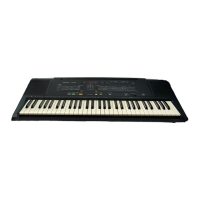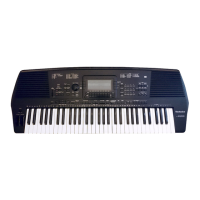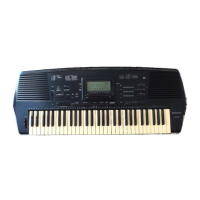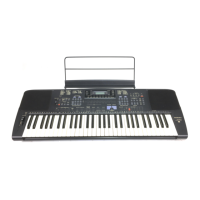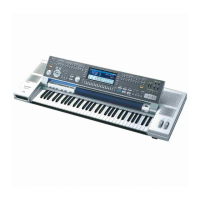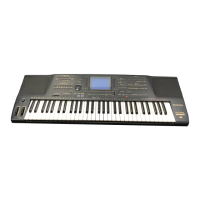
Do you have a question about the Technics SX-KN400 and is the answer not in the manual?
| Number of Keys | 61 |
|---|---|
| MIDI | Yes |
| Display | LCD |
| Amplifier | 6W + 6W |
| Polyphony | 32 notes |
| Effects | Reverb, Chorus |
| Connectivity | MIDI In/Out |
| Keyboard | Touch-sensitive |
| Sound Engine | AWM (Advanced Wave Memory) |
| Speakers | 2 x 12 cm |
Outlines the manual's organization into basic functions, practical applications, and reference sections.
Explains core features of the KN200 like Auto Play Chord, Sound Select, and Rhythm Select.
Details core features of the KN400 like Auto Play Chord, Composer, and Sound Select.
Guide to connecting power, setting up the music stand, and powering on the KN200 keyboard.
Instructions for powering on the KN400, including connecting power and setting up the music stand.
Learn how to play and navigate through the keyboard's preset demonstration performances.
How to select sounds on the KN200 using the Sound Select matrix and VARIATION button.
Instructions for selecting sounds for KN400 parts and utilizing the keyboard split function.
How to adjust volume levels for DRUMS, BASS, ACCOMP, and POLY parts using BALANCE buttons.
Details DIGITAL CELESTE and SUSTAIN effects and how to set them.
Using the Pitch Bend wheel to alter pitch and create string-bending effects.
Setting the vibrato depth for modulation data and the instrument's control.
Guide to shifting the instrument's key using the TRANSPOSE control.
How to store and recall panel settings for sounds, effects, and conductor settings.
Instructions on choosing rhythms from the matrix and starting playback with Start/Stop.
How to use introductions, endings, and fill-in patterns within rhythms.
Using the KEYBOARD PERCUSSION button to activate percussion sounds and their effects.
Storing and playing percussion sounds using the MANUAL PERCUSSION buttons.
Learn to adjust rhythm tempo and insert fill-in or intro/ending patterns.
Guide to using Auto Play Chord for automatic accompaniment patterns that match selected rhythms.
Details on adjusting total and individual part volumes for the Auto Play Chord.
Managing accompaniment part settings and utilizing the break function for rhythm control.
Detailed steps for storing chord progressions in the sequencer memory for playback.
Instructions for playing back chord progressions stored in the sequencer.
Guide to recording keyboard performances in the sequencer for automatic playback.
Steps to play back performances from the sequencer, including playback controls.
Instructions for creating and editing rhythm patterns in the Composer, including part selection.
Step-by-step instructions for recording and storing drum patterns using the Composer.
Instructions for recording and storing bass patterns using the Composer, including sound selection.
Guide to recording and storing the ACCOMP 1 pattern using the Composer, including sound selection.
Instructions for storing ACCOMP 2/3 parts, finishing rhythm storage, and understanding the QUANTIZE function.
How to modify rhythms and store them using the Composer.
Guide to playing back rhythm patterns stored in the Composer.
A summary outlining the process of storing parts (DRUMS, BASS, ACCOMP) in the Composer.
Covers safe installation, power handling, cord safety, and avoiding internal contact.
Details maintenance practices and actions for abnormal operation or water ingress.
Addresses issues with sound production, effects, rhythm not sounding, and tempo display.
Resolves problems with accompaniment patterns, sequencer errors, and multi-track recording.
Provides detailed explanations on sound, effect, and rhythm functions for practical use.
Provides detailed explanations of Sequencer, Composer, Function Setting, and MIDI functions.
Explains how the sequencer stores performances, sound, panel settings, and rhythm.
Guide to setting sounds, rhythms, and storing individual parts (multi-track) into the sequencer.
Steps to play back performances from the sequencer, including playback controls.
Details on sequencer storage capacity, counting notes, and managing available space.
Instructions for recording multiple parts simultaneously using the sequencer.
Utilizing the STEP RECORD function to store chord progressions for the ACCOMP/CHORD part.
Playing back stored chord sequences and storing rhythm changes, fill-ins, and endings.
A practical example demonstrating how to store chord progressions, rhythms, and changes in the sequencer.
Procedures for clearing specific parts or the entire sequencer contents for KN200 and KN400.
Instructions for creating and editing rhythm patterns in the Composer, including part selection.
Step-by-step instructions for recording and storing drum patterns using the Composer.
Instructions for recording and storing bass patterns using the Composer, including sound selection.
Guide to recording and storing the ACCOMP 1 pattern using the Composer, including sound selection.
Instructions for storing ACCOMP 2/3 parts, finishing rhythm storage, and understanding the QUANTIZE function.
How to modify rhythms and store them using the Composer.
Guide to playing back rhythm patterns stored in the Composer.
A summary outlining the process of storing parts (DRUMS, BASS, ACCOMP) in the Composer.
How to fine-tune the instrument's pitch using the TUNING function.
Details on storable settings in expanded PANEL MEMORY mode for KN400.
Procedure for assigning functions like rhythm start/stop or glide effect to the foot switch.
Setting vibrato depth for modulation data and the instrument's control.
Steps to reset sequencer, composer, MIDI, and other settings to factory presets.
Explains MIDI (Musical Instrument Digital Interface) and its capabilities for connecting instruments.
Details MIDI applications and the use of MIDI terminals (IN, OUT, THRU).
Lists the types of MIDI data that can be transmitted and received.
Illustrates common MIDI connection setups for generating sound and controlling devices.
Explains the 16 basic MIDI channels and default assignments for keyboard parts.
An outline of procedures for setting various MIDI functions like receive/transmit modes and clock settings.
Guide to selecting parts and setting their basic MIDI channels using the SOUND SELECT matrix.
Explains local control settings and how to set MIDI receive modes.
Details transmit modes, program change settings, note data transmission, and MIDI clock options.
How to enable or disable the transmission/reception of start/stop data.


